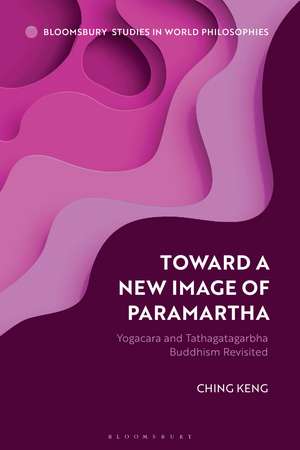Toward a New Image of Paramartha: Yogacara and Tathagatagarbha Buddhism Revisited: Bloomsbury Studies in World Philosophies
Autor Dr Ching Kengen Limba Engleză Paperback – 29 mai 2024
| Toate formatele și edițiile | Preț | Express |
|---|---|---|
| Paperback (1) | 193.07 lei 6-8 săpt. | |
| Bloomsbury Publishing – 29 mai 2024 | 193.07 lei 6-8 săpt. | |
| Hardback (1) | 541.44 lei 6-8 săpt. | |
| Bloomsbury Publishing – 2 noi 2022 | 541.44 lei 6-8 săpt. |
Preț: 193.07 lei
Preț vechi: 250.30 lei
-23% Nou
Puncte Express: 290
Preț estimativ în valută:
36.96€ • 40.16$ • 31.06£
36.96€ • 40.16$ • 31.06£
Carte tipărită la comandă
Livrare economică 21 aprilie-05 mai
Preluare comenzi: 021 569.72.76
Specificații
ISBN-13: 9781350303942
ISBN-10: 1350303941
Pagini: 304
Ilustrații: 10 bw illus
Dimensiuni: 156 x 234 x 25 mm
Greutate: 0.43 kg
Editura: Bloomsbury Publishing
Colecția Bloomsbury Academic
Seria Bloomsbury Studies in World Philosophies
Locul publicării:London, United Kingdom
ISBN-10: 1350303941
Pagini: 304
Ilustrații: 10 bw illus
Dimensiuni: 156 x 234 x 25 mm
Greutate: 0.43 kg
Editura: Bloomsbury Publishing
Colecția Bloomsbury Academic
Seria Bloomsbury Studies in World Philosophies
Locul publicării:London, United Kingdom
Caracteristici
Compares the terminology and style of phrasing of the Dunhuang fragment with Paramartha's corpus
Notă biografică
Ching Keng is Associate Professor of Buddhist Philosophy at the National Taiwan University, Taipei, Taiwan.
Cuprins
List of Tables and FiguresAbbreviations and Convention Introduction 1. Two Competing Readings of the Notion of Jiexing2. Doubts about the Connection between the Awakening of Faith in Mahayana and Paramartha 3. A Philological Investigation of Dunhuang Fragment T2805 4. Doctrinal Coherence between T2805 and the Works of Paramartha5. Two Shelun Lineages and How the Awakening of Faith Came to be Attributed to Paramartha6. What Exactly is Jiexing?7. Paramartha as a Successor to Vasubandhu Conclusion Notes BibliographyIndex
Recenzii
Prosecuting the case that the traditional image of Paramartha is inaccurate, in this articulate and innovative monograph Ching Keng combines philological, historical and doctrinal analyses in order to recover Paramartha's authentic teachings. To that end, Keng also boldly challenges the view that Yogacara and Tathagatagarbha were antagonistic traditions in India.
A creative and very solid study on the Indian scholar-monk Paramartha, who made a significant mark on Chinese Buddhist translation practices. With consideration toward Paramartha's diction and thought, Keng develops intriguing arguments concerning how and why the famed Awakening of Faith appeared as Paramartha's translation in medieval China.
For well over a century Chinese, Japanese, and Western scholars have labored over the question of how, why, and with what warrant the Yogacara and Tathagatagarbha traditions of Indian Mahayana Buddhism came to be so distinctively and consequentially intertwined in Chinese Buddhist thought. The focus of these labors has long been the inestimably influential text known as the Mahayana Awakening of Faith (Dasheng qixin lun) and its alleged association with the work of the Indian Missionary Paramartha. In this learnèd and rigorously argued study, Keng has given us a Paramartha untethered from the Awakening of Faith thereby allowing us to see him more clearly as a faithful, albeit original, exponent of Yogacara doctrine. Keng's exemplary study will surely came to be recognized as essential to all future study of the medieval development of Chinese- and Indian - Buddhist doctrine.
A creative and very solid study on the Indian scholar-monk Paramartha, who made a significant mark on Chinese Buddhist translation practices. With consideration toward Paramartha's diction and thought, Keng develops intriguing arguments concerning how and why the famed Awakening of Faith appeared as Paramartha's translation in medieval China.
For well over a century Chinese, Japanese, and Western scholars have labored over the question of how, why, and with what warrant the Yogacara and Tathagatagarbha traditions of Indian Mahayana Buddhism came to be so distinctively and consequentially intertwined in Chinese Buddhist thought. The focus of these labors has long been the inestimably influential text known as the Mahayana Awakening of Faith (Dasheng qixin lun) and its alleged association with the work of the Indian Missionary Paramartha. In this learnèd and rigorously argued study, Keng has given us a Paramartha untethered from the Awakening of Faith thereby allowing us to see him more clearly as a faithful, albeit original, exponent of Yogacara doctrine. Keng's exemplary study will surely came to be recognized as essential to all future study of the medieval development of Chinese- and Indian - Buddhist doctrine.









